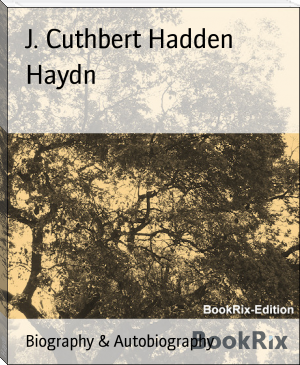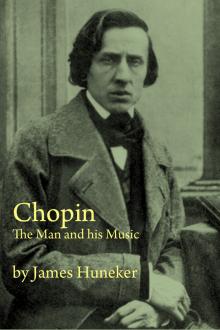Haydn, J. Cuthbert Hadden [books for new readers .TXT] 📗

- Author: J. Cuthbert Hadden
Book online «Haydn, J. Cuthbert Hadden [books for new readers .TXT] 📗». Author J. Cuthbert Hadden
Haydn's opinion of Beethoven's future was not so dogmatically expressed; but he must have been sorely puzzled by a pupil who looked upon even consecutive fifths as an open question, and thought it a good thing to "learn occasionally what is according to rule that one may hereafter come to what is contrary to rule." It is said that Haydn persisted in regarding Beethoven, not as a composer at all but as a pianoforte player; and certainly Beethoven regarded Haydn as being behind the age. That he was unjust to Haydn cannot be gainsaid. He even went so far as to suspect Haydn of willfully trying to retard him in his studies, a proceeding of which Haydn was altogether incapable. For many years he continued to discharge splenetic remarks about his music, and he was always annoyed at being called his pupil. "I never learned anything from Haydn," he would say; "he never would correct my mistakes." When, the day after the production of his ballet music to Prometheus, he met Haydn in the street, the old man observed to him: "I heard your music last night; I liked it very well." To which Beethoven, alluding to Haydn's oratorio, replied: "Oh! dear master, it is far from being a CREATION." The doubtful sincerity of this remark may be inferred from an anecdote quoted by Moscheles. Haydn had been told that Beethoven was speaking depreciatingly of "The Creation." "That is wrong of him," he said. "What has HE written, then? His Septet? Certainly that is beautiful; nay, splendid."
Beethoven on Haydn
It is hardly necessary to say who comes out best in these passages at arms. Yet we must not be too hard on Beethoven. That he recognized Haydn's genius as a composer no careful reader of his biography can fail to see. As Pohl takes pains to point out, he spoke highly of Haydn whenever opportunity offered, often chose one of his themes when improvising in public, scored one of his quartets for his own use, and lovingly preserved the autograph of one of the English symphonies. That he came in the end to realize his true greatness is amply proved by the story already related which represents him as exclaiming on his death-bed upon the fact of Haydn having been born in a common peasant's cottage.
In the meantime, although Beethoven was dissatisfied with his progress under Haydn, there was no open breach between the two. It is true that the young musician sought another teacher--one Schenck, a well-known Viennese composer--but this was done without Haydn's knowledge, out of consideration, we may assume, for his feelings. That master and pupil were still on the best of terms may be gathered from their having been at Eisenstadt together during the summer of 1793. In the January of the following year Haydn set out on his second visit to England, and Beethoven transferred himself to Albrechtsberger.
The Haydn Museum
Haydn's life in Vienna during the eighteen months which intervened between the two London visits was almost totally devoid of incident. His wife, it will be remembered, had written to him in England, asking for money to buy a certain house which she fancied for a "widow's home." Haydn was astute enough not to send the money, but on his return to Vienna, finding the house in every way to his liking, he bought it himself. Frau Haydn died seven years later, "and now," said the composer, speaking in 1806, "I am living in it as a widower." The house is situated in the suburb of Vienna known as Gumpendorf. It is No. 19 of the Haydngasse and bears a marble memorial tablet, affixed to it in 1840. The pious care of the composer's admirers has preserved it almost exactly as it was in Haydn's day, and has turned it into a kind of museum containing portraits and mementoes of the master, the original manuscript of "The Creation," and other interesting relics.
Starts for London
Haydn started on his journey to England on January 19, 1794, Salomon having brought him, under a promise to return with six new symphonies which be was to conduct in person. This time he travelled down the Rhine, and he had not been many days on the way when news reached him of the death of Prince Anton Esterhazy, who had very reluctantly given him leave of absence. On the occasion of the first London visit Salomon had been his travelling companion; now, feeling doubtless the encumbrance of increasing years, Haydn took his servant and copyist, Johann Elssler, along with him.
Honest Elssler
It may be noted in passing that he entertained a very warm regard for Elssler, whose father had been music copyist to Prince Esterhazy. He was born at Eisenstadt in 1769, and, according to Pohl, lived the whole of his life with Haydn, first as copyist, and then as general servant and factotum. It was Elssler who tended the composer in his last years, a service recompensed by the handsome bequest of 6000 florins, which he lived to enjoy until 1843. No man, it has been said, is a hero to his valet, but "Haydn was to Elssler a constant subject of veneration, which he carried so far that when he thought himself unobserved he would stop with the censer before his master's portrait as if it were the altar." This "true and honest servant" copied a large amount of Haydn's music, partly in score, partly in separate parts, much of which is now treasured as the autograph of Haydn, though the handwritings of the two are essentially different. It is a pity that none of the earlier writers on Haydn thought of applying to Elssler for particulars of the private life of the composer. He could have given information on many obscure points, and could have amplified the details of this second London visit, about which we know much less than we know about the former visit.
The Salomon Concerts
Salomon's first concert had been arranged for the 3rd of February, but Haydn did not arrive until the 4th, and the series accordingly began upon the 10th. Twelve concerts were given in all, and with the most brilliant success. The six new symphonies commissioned by Salomon were performed, and the previous set were also repeated, along with some new quartets. Of the many contemporary notices of the period, perhaps the most interesting is that which appears in the Journal of Luxury and Fashion, published at Weimar in July 1794. It is in the form of a London letter, written on March 25, under the heading of "On the Present State and Fashion of Music in England." After speaking of Salomon's efforts on behalf of classical music and of the praise due to him for his performance of the quartets of "our old favourite, Haydn," the writer continues: "But what would you now say to his new symphonies composed expressly for these concerts, and directed by himself at the piano? It is truly wonderful what sublime and august thoughts this master weaves into his works. Passages often occur which render it impossible to listen to them without becoming excited. We are altogether carried away by admiration, and forced to applaud with hand and mouth. This is especially the case with Frenchmen, of whom we have so many here that all public places are filled with them. You know that they have great sensibility, and cannot restrain their transports, so that in the midst of the finest passages in soft adagios they clap their hands in loud applause and thus mar the effect. In every symphony of Haydn the adagio or andante is sure to be repeated each time, after the most vehement encores. The worthy Haydn, whose personal acquaintance I highly value, conducts himself on these occasions in the most modest manner. He is indeed a good-hearted, candid, honest man, esteemed and beloved by all."
Several notable incidents occurred at the Salomon Concerts. It has been remarked, as "an event of some interest in musical history," that Haydn and Wilhelm Cramer appeared together at one concert, Cramer as leader of the orchestra, Haydn conducting from the pianoforte. But Cramer was not a genius of the first rank-- his compositions are of the slightest importance--and there was nothing singular about his appearing along with Haydn. He had been leader at the Handel Festivals at Westminster Abbey in 1784 and 1787, and was just the man to be engaged for an enterprise like that of Salomon's.
A "Smart" Drummer
An anecdote told of Haydn in connection with one of the rehearsals is better worth noting. The drummer was found to be absent. "Can anyone here play the drum?" inquired Haydn, looking round from his seat at the piano. "I can," promptly replied young George (afterwards Sir George) Smart, who was sitting among the violinists. Smart, who lived to become the doyen of the musical profession in England, had never handled a drumstick before, and naturally failed to satisfy the conductor. Haydn took the drumstick from him and "showed to the astonished orchestra a new and unexpected attitude in their leader." Then, turning to Smart, he remarked: "That is how we use the drumsticks in Germany." "Oh, very well," replied the unabashed youth, "if you like it better in that way we can also do it so in London."
New Acquaintances
Haydn made several new acquaintances during this visit, the most notable being, perhaps, Dragonetti, the famous double-bass player, who had accompanied Banti, the eminent prima donna, to London in 1794. Banti had been discovered as a chanteuse in a Paris cafe, and afterwards attracted much notice by her fine voice both in Paris and London. "She is the first singer in Italy, and drinks a bottle of wine every day," said one who knew her. In her journeys through Germany, Austria and Italy she won many triumphs. Haydn composed for her an air, "Non Partir," in E, which she sang at his benefit. As for "Old Drag," the familiar designation of the distinguished bassist, his eccentricities must have provided Haydn with no little amusement. He always took his dog Carlo with him into the orchestra, and Henry Phillips tells us that, having a strange weakness for dolls, he often carried one of them to the festivals as his wife! On his way to Italy in 1798 Dragonetti visited Haydn in Vienna, and was much delighted with the score of "The Creation," just completed. Several eminent violinists were in London at the time of Haydn's visit. The most distinguished of them was perhaps Felice de Giardini, who, at the age of fourscore, produced an oratorio at Ranelagh Gardens, and even played a concerto. He had a perfectly volcanic temper, and hated Haydn as the devil is said to hate holy water. "I don't wish to see the German dog," he remarked in the composer's hearing, when urged to pay him a visit. Haydn, as a rule, was kindly disposed to all brother artists, but to be called a dog was too much, He went to hear Giardini, and then got even with him by noting in his diary that he "played like a pig."
The accounts preserved of Haydn's second visit to England are, as already remarked, far less full than those of the first visit. Unconnected memoranda appear in his diary, some of which are given by Griesinger and Dies; but they are of comparatively little interest. During the summer of 1794 he moved about the country a good deal. Thus, about the 26th of August, he paid a visit to Waverley Abbey, whose "Annales Waverliensis" suggested to Scott the name of his first romance. The ruined condition of the venerable pile--it dates from 1128--set Haydn moralizing on the "Protestant heresy" which led the "rascal mob" to tear down "what had once been a stronghold of his own religion."
Haydn at Bath
In the following month he spent three days in Bath with Dr Burney, and Rauzzini, the famous tenor,





Comments (0)